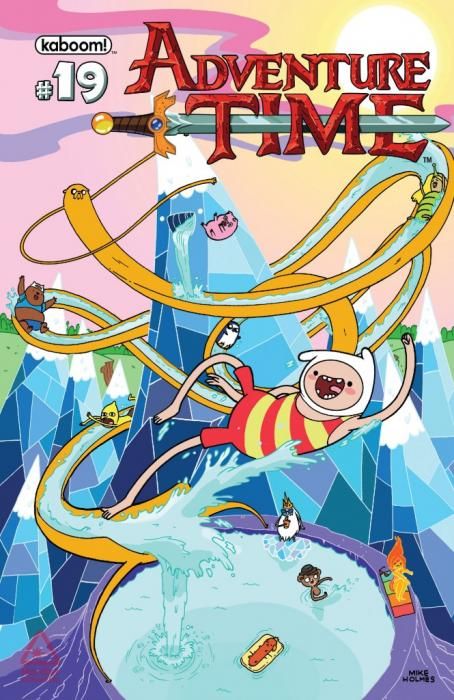In "Adventure Time" #19, the main story by Ryan North, Shelli Paroline and Braden Lamb has a set-up that is a cross between "Sliders" and "Coraline." The Lich has created multiple alternate realities populated with evil, fake Lich-versions of Finn and Jake and supporting cast members. The only other "real" dimensional traveler is Ice King.
The typical overarching theme of Finn and Jake's friendship dominates the conflict resolution, but the sub-story of Ice King's romance with an illusion is most fascinating part of North's story. Ice King has found love with Lich-creature Betty, and their romance is remarkably cute (as are Betty's hipster girl spectacles). It's tragic when she crumbles, saying "Simon, I don't feel fake!" with nary a peep of the evil Lich-ness inside to take the sting off her "death." The pause when Finn and Jake look at each other sadly in the wake of Ice King's heartbreak is a wonderful emotional beat, making the concluding scene of reconciliation and friendship even more poignant.
Paroline and Lamb's art is upbeat but has a nice dose of creepiness in the angry eyes of the Lich people or the bean-bag-doll body of Stretchy Lich-Finn. Their colors and action-filled pages are as bright and clear as always, and their grasp of body language strengthens the story, which is more emotionally fraught than the usual manic "Adventure Time" fare.
"Adventure Time" is an episodic series, like the show that it spun off from, but that hasn't prevented it from maintaining continuity or using complex themes. Ice King started off as a lonely mean monarch. His obsession with abducting princesses was mildly pervy and disturbing, but oddly fitting due to his inability to form good social relationships. Ice King's gradual shift from pathetic villain into a sometimes-ally and friend to Finn and Jake has been an unusual and rewarding character arc. In the beginning, his solitude was a foil to Finn and Jake's dyad, but in recent stories, he's evolved into being a symbol of the search for love.
The six-page backup story, "Ambitreacherous," by Andy Hirsch has a clever title and execution. The flip-book format, with two stories/characters meeting in the middle of the comic, has been used before, most recently in Lemire's "Trillium" #1. Tricks like these take advantage of the comics medium's unique physical format. Hirsch's take is distinctive in use of the panel gutters and in making the reader turn the page round-and-round as much as possible. He also crowds the panels, building anticipation for the climax/collision of the central convergence.
Both the main story and the backup in "Adventure Time" #19 focus on friendship, but North and Paroline's story is dominated by character complexity and word play, while Hirsch's story is dominated by physical or visual complexity. The two stories pair well, showing off the humor and dense, skillful storytelling that "Adventure Time" consistently features.

